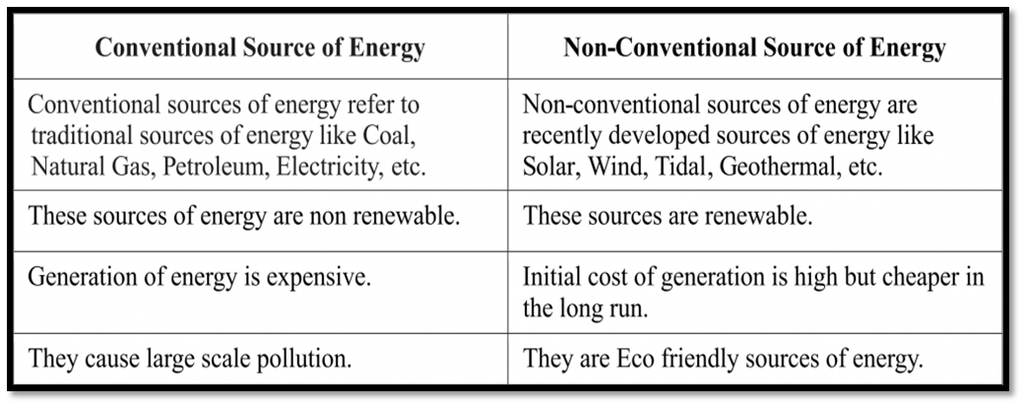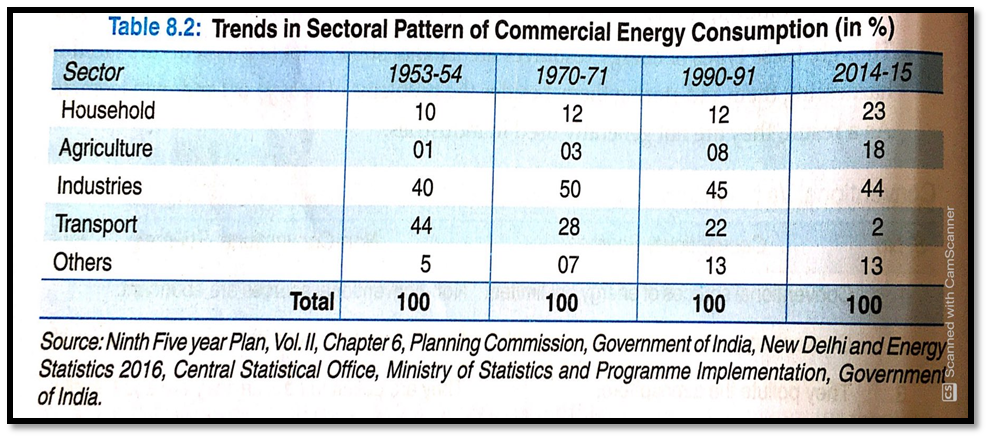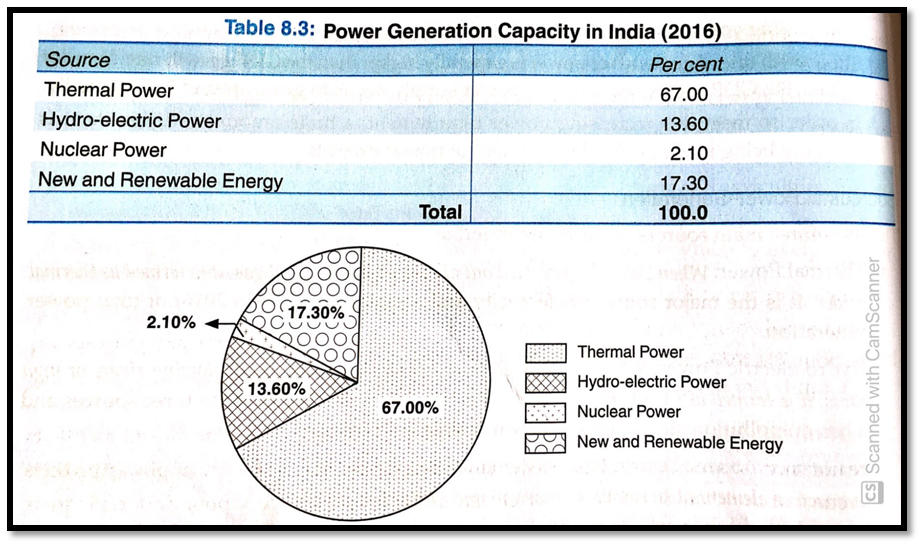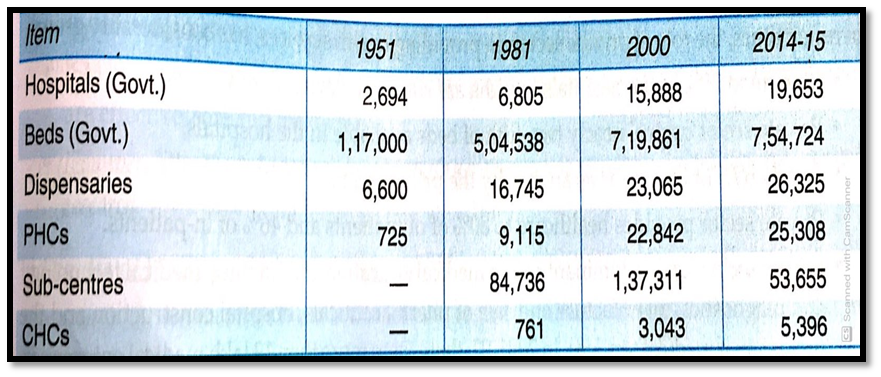Energy
- There exist a positive correlation between economic growth and demand for energy. It happens because growth is an index of increasing productive activity, which requires a larger quantity of energy.
- In India, energy is used on a large-scale in agriculture and related areas, like production and transportation of fertilizers, pesticides and farm equipment.
- Energy is required in houses for cooking, household lighting and heating.
Commercial Energy
- Commercial Energy refers to those sources of energy, which those sources of energy, which command a price and the users, have to pay a price for them.
- For example, coal, petroleum and electricity.
- Commercial sources of energy are generally exhaustible (except hydropower).
Non-Commercial Energy
- Non-Commercial energy consists of those sources of energy, which generally do not command a price.
- For example, firewood, agricultural waste and dried dung.
- Non-commercial sources are generally renewable.
- These are generally available free of cost as they are found in nature or forests.
- More than 60% of Indian households depend on traditional sources of energy for meeting their regular cooking and heating needs.
Commercial Energy Vs Non-Commercial Energy

Conventional Sources of Energy
- Conventional sources of energy refer to the sources of energy, which are in use for a long and can be stored. For example, coal and oil.
- Such sources are non-renewable resources of energy.
- Even today, most of the industries of the world make use of coal and oil in industries.
- Both commercial and non-commercial sources of energy are known as conventional sources of energy.
Non-Conventional Sources of Energy
- Non-Conventional sources of energy refer to the sources of energy, which have come into use only recently. For example, solar energy, wind energy, geothermal energy, bio-gas, and tidal power.
- Such sources are renewable resources of energy.
- Being a tropical country, India has almost unlimited potential for producing these types of energy, if some appropriate cost-effective technologies, that are already available, are used.
- However, these types of energy resources are inexhaustible; many problems are faced in harnessing them and storing them, besides the problems of heavy cost and management. As a result, they are not generally used in industries.
Conventional Vs Non-Conventional Sources of Energy

Primary and Secondary Sources of Energy
- Primary Sources: Primary or direct sources of energy are gifts of nature and they do not need any transformation for using them. For example, Coal, petroleum, or gas are primary sources as they can be directly used for work by burning.
- Secondary Sources: Secondary or indirect sources of energy result from the transformation of primary sources. For example, Electricity is a secondary form of energy produced from Primary energy resources including coal, hydrocarbons, hydro energy, nuclear energy, etc.
Consumption Pattern of Energy in India
- Commercial energy consumption makes up about 74% of the total energy consumed in India. This includes coal with the largest share of 54%, followed by oil at 32%, natural gas at 10% and hydro energy at 2%.
- Non-commercial energy sources consisting of firewood, cow dung and agricultural wastes, account for over 26% of the total energy consumption.
- India depends on imports for crude and petroleum products, which is likely to grow rapidly in the near future.
Sectoral Pattern of Consumption of Commercial Energy
- The industrial sector has the largest share of 44% of the total consumption of commercial energy.
- Share of the transport sector in consumption of commercial energy decreased from 44% in 1953 54 to just 2% in 2014-15. There has been a continuous fall in the share of the transport sector, while the shares of the household, agriculture and industrial sector have been increasing.
- Consumption of commercial energy by the agricultural sector is very less (18%). It shows the dependence of the agriculture sector on traditional methods of farming.
- The share of oil and gas is the highest among all commercial energy consumption.
- With the rapid rate of economic growth, there has been a corresponding increase in the use of energy.

POWER (ELECTRICITY)
- Power or electricity is a critical component of infrastructure, which is often identified with progress in modern civilization.
- In order to attain economic development, power is required in every step.
- With the gradual development of various sectors of the economy, the demand for power is increasing year after year.
- The growth rate of demand for power is generally higher than the GDP growth rate. In order to have an 8% GDP growth per annum, the power supply needs to grow around 12% annually.
- In order to meet this increasing power requirement, a huge amount of investment is regularly being made in the development of power projects.
Sources of Power Generation
- Thermal Power: When power is generated out of coal, oil and natural gas, it is termed thermal power. It is the major source of electricity and accounts for 67% in 2016) of total power generation.
- Hydro-electric Power: When power is generated from the waters of fast-flowing rivers or high dams, it is termed hydroelectric power. It is the cheapest among all the three sources and it has no pollution agent. It is a renewable source of energy.
- Nuclear or Atomic Power: When power is generated from radioactive elements like uranium, thorium and plutonium, it is termed nuclear or atomic power. It is the next most up-to-date source of power, whose generation has started mostly from 1970-71. Atomic energy has environmental advantages and is also likely to be economical in the long run.
Power Generation Capacity of Various Sources
In order to keep pace with the growing demand for power from various sectors, a number of steps have been taken to increase power generation. As a result, the generation of power in thermal, hydroelectric and nuclear projects has increased considerably. The installed power generation capacity increased from 1,700 Megawatts (MW) in 1950-51 to 1,24, 300 MW at the end of 2005-2006.
- Thermal Power: In India, the biggest source of power generation is thermal power. 679 of the power generation capacity comes from thermal sources.
- Hydro-electric Power: Hydroelectric power accounts for 13.60% of total power generation capacity.
- Nuclear Power: Nuclear Power accounts for only 2.10% of the total installed capacity of electricity (against the global average of 13%). Some scholars suggest generating more electricity through atomic (nuclear) sources, while few others object to this, from the viewpoint of environment and sustainable development.

Challenges in the Power Sector
- Inadequate adequate Electricity Generation: India’s installed capacity to generate electricity is sufficient to feed an annual economic growth of 7-8%. In order to meet the growing demand for electricity, India's commercial energy supply needs to grow at about 7%. At present, India is able to - Limited Role of Private and Foreign Entrepreneurs L Lack of Public Cooperation add only 2, 00,000 MW a year.
- Underutilisation of installed capacity: The installed capacity is underutilized, as plants are not run properly. During excess demand, the operational efficiency of power projects is reflected by the ‘Plant Load Factor (PLF). In India, the PLF is very poor and inadequate attention is paid to improving it.
- Poor performance of State Electricity Boards (SEBs): State Electricity Boards (SEBs), which distribute electricity, incur losses, which exceed 500 billion. This is due to transmission and distribution losses, wrong pricing of electricity and other operational inefficiencies. A large portion of these losses is due to theft of power and the free supply of power to agriculture.
- Shortage of inputs: Thermal power plants, which are the foundation of India's power sector, are facing a shortage of raw material and coal supplies.
- Limited role of Private and Foreign Entrepreneurs: Private sector power generators and foreign investors are yet to play their role in a major way.
- Lack of Public Cooperation: There is general public unrest due to high power tariffs and prolonged power cuts in different parts of the country.
The Delhi Electric Supply Power Distribution:
- The Delhi State Electricity Board (DSEB) was set up in 1951. This was succeeded by Delhi Electric Supply Undertaking (DESU) in 1958 and by Delhi Vidyut Board (DVB) in 1997. After the privatization of the DVB, it rests with two leading Private players:
- Reliance Energy Ltd. (BSES), which manages the power distribution of two-thirds of Delhi:
- Tata Power (TPDDL), which distributes power to the remaining one-third.
- The tariff structure and other regulatory issues are monitored by the Delhi Electricity Regulatory Commission (DERC). It was expected that there will be a greater improvement in power distribution and the consumers will benefit in a major way. However, there are unsatisfactory results until now.
Measures to meet Power Crisis:
- Improvement in Plant Load Factor Factor (PLF): The Plant Load Factor is an important indicator of the operational efficiency of thermal. Improvement in PLF will help better the utilization of the capacity of the plant.
- Control of Transmission and Distribution Losses: To solve the power crisis, transmission and distribution losses should be effectively controlled as they adversely affect the financial health of power utilities.
- Increase in Productive Capacity: In India, there is an underutilization of the productive capacity of thermal power stations. Its productive capacity should be increased to control the power crisis.
- Promote the role of the Private Sector: Although the private sector has made some progress, it is necessary to tap this sector to come forward and produce power on a large scale. India is the world's fifth-largest producer of wind power, with more than 95% of investments coming from the private sector.
- Encourage the use of renewable sources: The use of renewable energy sources can ensure an additional supply of electricity. With the large availability of biomass in India, there is significant potential for meeting energy needs, particularly in rural and remote areas. Greater reliance on renewable energy resources offers enormous economic, social and environmental benefits.
- Development of Hydro Potential: India is quite rich in Hydropower potential with an estimated hydropower potential of more than 1, 50,000 MW. However, only 21.14% of the potential has been developed to date. So, there is a serious need to fully expose the potential of hydropower.
- Other Measures: Other measures which can help in meeting the power crisis are: (i) an increase in public investment; (ii) Better research and development efforts; and (iii) Technological innovation.
HEALTH
In the words of WHO, ‘Health is a state of complete physical, mental and social well-being and not merely the absence of disease or infirmity.'
Important Points about Health and Health Infrastructure
- Health is not only the absence of disease but also the ability to realize one's potential. It is a yardstick of one's well-being.
- Health is the holistic process related to the overall growth and development of the nation.
- Health improves the efficiency and productivity of a person and he is able to contribute more to the economic development of a country.
- It is the responsibility of the government to ensure that health facilities are accessible to all people.
- It is difficult to define the health status of a nation in terms of a single set of measures. The health status is usually measured in terms of life expectancy at birth, infant mortality rates, maternal mortality rates and nutrition levels, along with the incidence of communicable and non-communicable diseases.
- Development of health infrastructure ensures a country of healthy manpower for the production of goods and services.
- Health infrastructure includes hospitals, doctors, nurses and other paramedical professionals, beds, equipment required in hospitals and a well-developed pharmaceutic industry. Mere presence of health infrastructure is not sufficient to have healthy people. It should be accessible to all the people.
- Health Infrastructure is an important indicator to understand the healthcare delivery provisions and mechanisms in a country. It also signifies the investments and priority accorded to the creation of infrastructure in the public and private sectors.
Health Status after Independence
- The Union Government evolves broad policies and plans through the Central Council of Health and Family Welfare.
- It collects information and renders financial and technical assistance to state governments, union territories and other Health Infrastructure bodies, for the implementation of important health programs lacking in large parts of the country.
- It is a well-known fact that India is the second-largest populated country in the world. But the health status of a great majority of the people is far from satisfactory as compared to China and other developed countries.
- However, over the last five decades, India has built up a health infrastructure and made considerable progress in improving the health of its population.
Expansion of Public Health Infrastructure
- At the village level, a variety of hospitals, technically known as Primary Health Com (PHC), have been set up by the government
- India also has a large number of hospitals run by voluntary agencies and the private hospitals are manned by professionals and para-medical professional trainee medical, pharmacy and nursing colleges.
- Since independence, there has been a significant expansion in the physical provision of health services. During 1951-2015:
- Number of hospitals and dispensaries increased from 9,294 to 45,978.
- Nursing personnel increased from 18,054 to 23.44 lakh;
- Allopathic Doctors increased from 61,800 to 9.2 lakh.

Three-tier system of health infrastructure:
- Primary Health Care: Primary Health Care includes:
- Education concerning prevailing health problems and methods of identifying, preventing and controlling them;
- Promotion of food supply and proper nutrition and adequate supply of water and was water and basic sanitation;
- Maternal and child health care;
- Immunization against major infectious diseases and injuries;
- Promotion of mental health and provision of essential drugs.
- In order to provide primary health care. Primary Health Centres (PHC), Community Health Centres (CHC) and Sub-centres (SC) have been set up in villages and small towns. They are generally manned by a single doctor, a nurse and a limited quantity of medicines. When the condition of a patient is not managed by such centers, they are referred to secondary or tertiary hospitals.
- Secondary Health Care: Hospitals, which have better facilities for surgery, Electro Cardio Gram (ECG), is called secondary health care institutions. They provide primary health care and also provide better healthcare facilities. They are mostly located in district headquarters and in big towns.
- Tertiary Health Care: Hospitals that have advanced level equipment and medicines and undertake all the complicated health problems, which could not be managed by primary and secondary hospitals, come under ‘Tertiary Health Care'. The tertiary sector also includes many premier institutes, which not only impart quality medical education and conduct research but also provide specialized health care. For example, AIIMS in Delhi.
Role of the Private Sector
- In recent times, the role of private sector, in providing health services, has considerably grown.
- More than 70% of the hospitals in India are run by the private sector.
- Private sector control nearly two-fifth of beds available in the hospitals.
- Nearly 60% of dispensaries are run by the private sector.
- Private sector provides healthcare to 80% of outpatients and 46% of in-patients.
- Private sector plays a dominant role in medical education and training, medical technol. and diagnostics, manufacture and sale of pharmaceuticals, hospital construction and provision of medical services. In 2001-02, there was more than 13 lakh medical enterprises employing 22 lakh people.
- Many NRIs and industrial and pharmaceutical companies have set up super-special hospitals to attract India's rich and medical tourists.
- However, the private sector in India has grown independently, without any major regulation. Some private practitioners are not even registered doctors and are known as quacks. The role of government in providing healthcare is still very important as poor people can depend only on government hospitals, due to huge expenses in private health services.
Community and Non-Profit Organisations in Healthcare
- It functions with the idea that people can be trained and involved in the primary healthcare system. For example, NGOs like SEWA in Ahmedabad and ACCORD in Nilgiris are working in India.
- Trade unions have built alternative health care services for their members, to give low cost and rational care to people from nearby villages. For example, Shahid Hospital, built-in 1983, is maintained by workers of Chhattisgarh Mines Shramik Sangh in Durg, Madhya Pradesh.
- Some rural organizations (like Kashtakari Sangathan in Thane, Maharashtra) have also made attempts to build alternative health-care initiatives.
Medical Tourism in India
- Health services in India combine the latest medical technologies with qualified professionals. Moreover, health services are cheaper in India as compared to the costs of similar health care services in other countries.
- As a result, foreigners come to India for surgeries, liver transplants, dental and even cosmetic care. In 2016, around 2, 01,000 foreigners visited India for medical treatment and by 2020, India could earn more than 500 billion rupees through such 'Medical Tourism'. However, India needs to upgrade its health infrastructure to attract more foreigners to India.

 PathSet Publications
PathSet Publications
